1985 Detroit Grand Prix race report
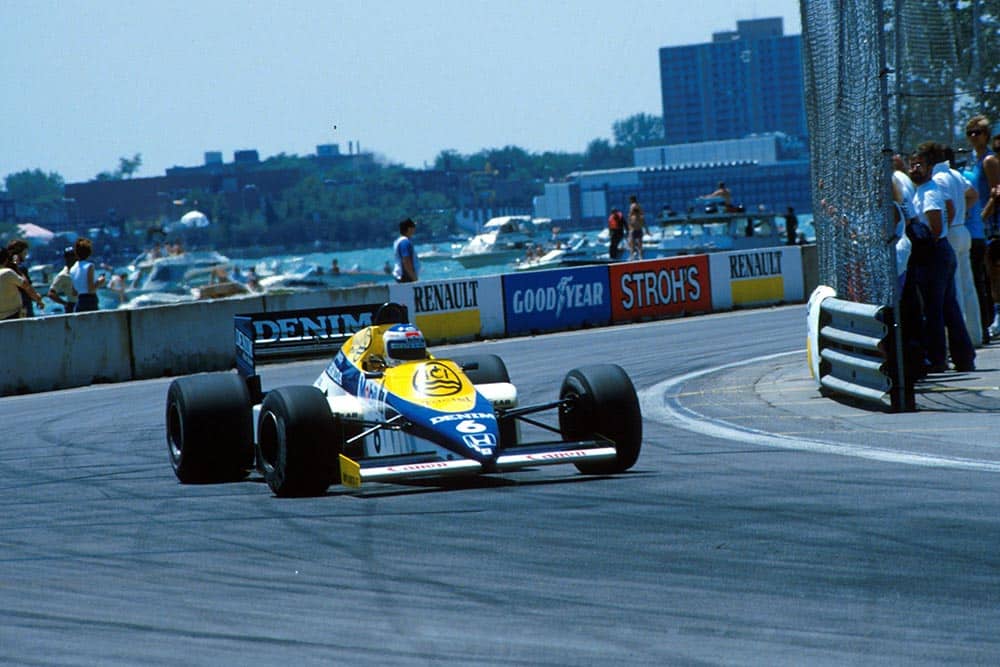
Williams' Keke Rosberg finally made some championship headway with his first win of the season
Motorsport Images
A Rosberg romp
Downtown Detroit, USA, June 23rd
No sooner was the Canadian Grand Prix finished in Montreal than the teams packed their bags and moved westwards and across the border into the United States; to set up camp in Downtown Detroit to prepare for the fourth running of the Detroit Grand Prix, round the streets of America’s Motor City. It is very much the home of Ford, General Motors and Renault America so that apart from being Television Entertainment and a round in the 1985 World Championship series, the Detroit race has pretty important industrial overtones. Ford took the opportunity to announce the official existence of a V6 turbocharged engine for Formula 1, designed by Keith Duckworth’s firm Cosworth Engineering of Northampton, with useful technology coming from Ford’s own Research and Development department. A three year contract has been made with American entrepreneur Carl Haas, who has the financial backing of the Beatrice empire, for the exclusive use by him of the Ford engine in his Lola-named Formula 1 car which will appear before the end of the year, using a Hart 4-cylinder engine, until the new Ford is ready for use in 1986.
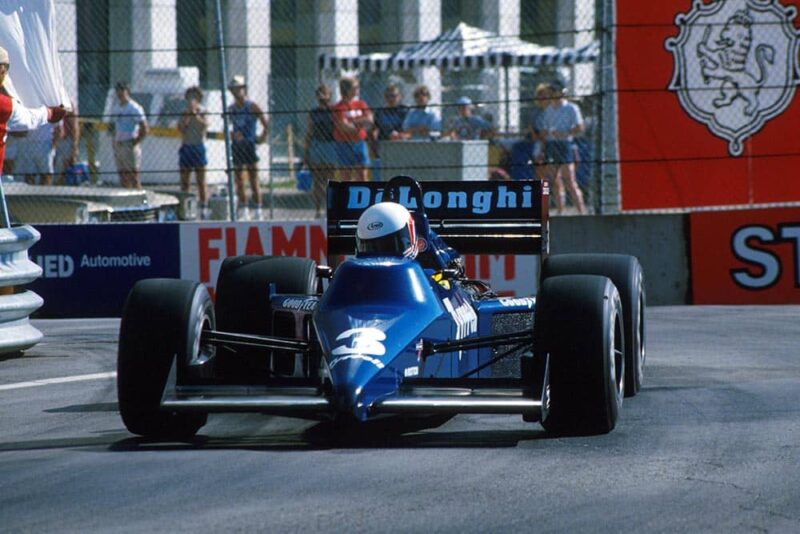
Martin Brundle started 18th for Tyrrell
Motorsport Images
On the national front, a Trans-Am race was held on Saturday afternoon, in which a Ford Mercury Capri finished first, and that evening, while Ford were celebrating, the news arrived that the scrutineers had found the winning car to be very much under the weight limit, so it was disqualified and a General Motors Buick was announced as the winner. The race organisers were not too popular with one section of “Motown”.
But to get to the real reason for the streets of Detroit being closed to normal traffic, and lined with concrete barriers and wire netting catch fencing. This was the 4th Detroit Grand Prix for Formula 1, itself something of note, for when the first Grand Prix happened in 1982, which John Watson won with a McLaren-Cosworth V8, which everyone seemed to think was made in Detroit(!). Mr Ford himself said he and his fellow industrialists were determined that the Grand Prix should become a permanent fixture, which many people viewed as “industrial big-talk”, but all credit to the Motor City, for here everyone was making ready for the fourth Grand Prix in a row at Detroit, and unlike some American races, there has never been a suspicion of doubt about its happening each year.
Like Monaco and the late-lamented Long Beach events, there is no opportunity for pre-race test sessions on the Detroit circuit. Drivers and engineers can only walk round the circuit or drive round in a private car and guess at what is needed and add it to past experience. Nobody has an opportunity of finding out what it is about until the green flag is given on Friday morning at the conventional 10 am start for the one-and-a-half hours of testing, preparatory to the one hour of qualifying between 1 pm and 2 pm. This usually means that the first day of activity does not see the best results, for apart from drivers having to acclimatise themselves to the conditions, and the cars having to be adjusted in all directions, the road surface 1s usually dusty and polished and it takes quite a bit of running by the Formula 1 cars to put down a layer of rubber on the racing line, which aids adhesion.
Qualifying
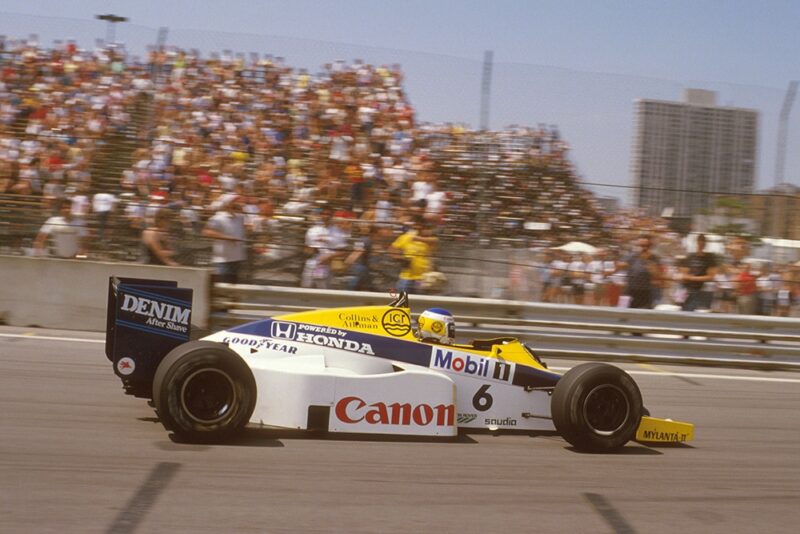
Keke Rosberg put his Williams 5th on the grid
Motorsport Images
With this being the seventh event in 1985 it is no longer a surprise to find Ayrton Senna and Lotus 97T-Renault V6 at the head of the practice times, and his time of 1 min 42.051 sec was in a class of its own, and that was on his fourth flying lap during qualifying. Last year Nelson Piquet made the fastest practice lap in 1 min 40.980 sec, so it was going to be no surprise if Senna got below 1 min 40 sec by the end of Saturday afternoon. However, the weather gods intervened and Saturday was a total loss, with rain and wind and conditions so miserable that only seven drivers ventured. out. There was no hope of anyone improving on his Friday time, so Friday saw the destination of grid positions. This meant that the grid arrangement was a bit artificial in places, but by and large those who should be near the front were there and those who are habitually at the back were also there. Lauda, Tambay, Patrese and de Cesaris were further back than they normally are.
One aspect of the first day of testing and qualifying was the amount of carnage. Elio de Angelis ran into the back of Tambay’s Renault, smashing up the front of the Lotus 97T and forcing both drivers to qualify with the T-cars; Berger’s Arrows came into hard contact with Patrese’s Alfa Romeo; Prost crumpled his McLaren when he had brake trouble, and the race marshals who retrieved Berger’s car on a breakdown lorry made a right old mess of it when they clanged it against a wall and it then fell off the hook from a great height. Remarkably, the Arrows mechanics were able to sort out the mess and get the car mobile again.
Race
With Saturday washed out there was only one thing to do and that was to hope for better weather on Sunday and make the most of the morning warm-up session. That is how it worked out, for Sunday was bright and sunny and the warm-up half-hour became all-important as suspension and aerodynamic settings were made and tyre choice decisions arrived at more by guesswork than anything else.
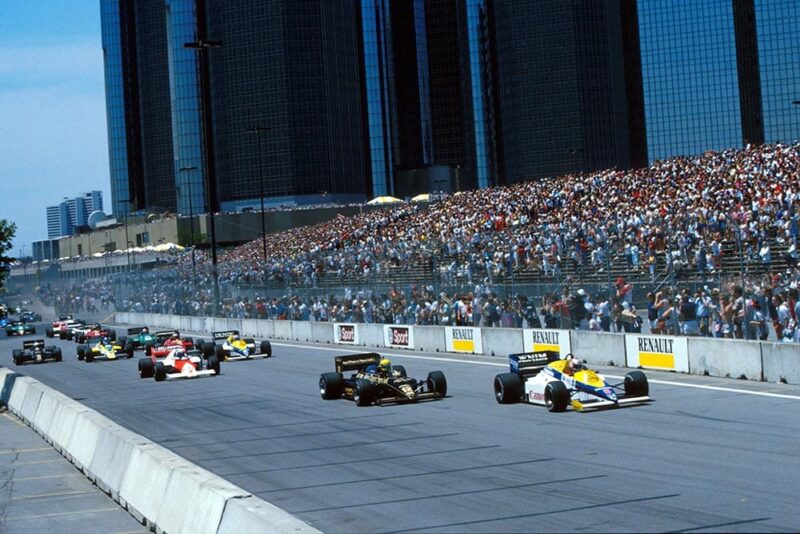
The race gets underway
Motorsport Images
The Goodyear runners had the choice of type A, type B and type C, varying from hard to soft, and most drivers chose As, while some chose a combination of As and Bs, but Rosberg : decided to gamble and run Bs on all four wheels. The under-powered Cosworthengined Tyrrells were able to use Cs on all four wheels. The Detroit circuit is hard on brakes, with its stop I go characteristics allowing little time for discs and pads to cool off, so those teams with the choice of carbon-fibre discs or steel discs, chose to run steel ones, but McLaren and Renault had no choice having committed themselves to carbon-fibre, so that a lot of large air cooling ducts were to be seen.
At the start Nigel Mansell made a real screamer from his second position on the grid, and actually took the lead from Senna as they wheeled into the first corner. His glory did not last long, for Senna sorted him out on the very next corner and was away into the lead on the opening lap. Rosberg soon got by his team-mate and put the pressure on Senna, so that it was not long before these two were out on their own. Rosberg had a distinct advantage with his softer tyres and it was only a matter of time before he was ready to pass the Lotus. Senna realised very quickly that the choice of AGoodyears was a mistake and, as he peeled off into the pits to change to a set of BGoodyears, Rosberg sailed by into the lead. The Lotus pit made a nonsense of things and slapped another set of A-Goodyears on instead of Bs, and Senna was away after a very quick stop, saying that he would be back later for a set of B-Goodyears.
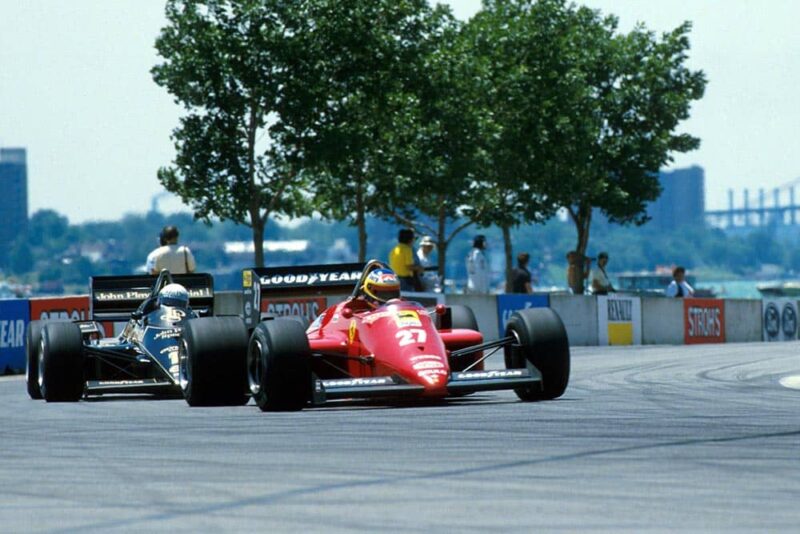
Ferrari’s Alboreto is chased by the Lotus of de Angelis
Motorsport Images
We now had the rare sight of the Williams-Honda cars running first and second, but not for long as Mansell’s car was sliding about rather uncontrollably on its harder tyres, and he fell back letting Prost and the two Ferraris move ahead, but Prost did not last long near the front, He was not happy with his brakes, and concerned about fuel consumption, so he eased off and let the others go. Rosberg had no worries out in front, looking as confident as ever and driving hard as he always does. There was a lot of paper and rubbish blowing about on the track and early on Piguet had stopped to have some of it removed from his radiator , intakes, and now Rosberg collected some and his temperatures began to rise, which made him keep a wary eye on his gauges.
Before a third distance had been run one particular corner was beginning to break up, causing ruts and a lot of loose “marbles” right on the racing line. First to fall foul of this was Tambay, who had a big spin and clouted the barriers with his left rear wheel, knocking it very much out of line. In a desperate move to get out of the line of fire Tambay gunned the Renault and shot across the track into the escape road, narrowly missing a collision with Surer’s Brabham. Lauda had given up with a lack of brakes on his McLaren and Warwick had come to rest out on the circuit with no drive to the rear wheels. Prost “lost” his McLaren on the “marbles” where Tambay had spun and went head-on into the barriers, and the marshals had not long removed the bent car than Mansell did the same thing and hit the same barriers. He had already had two spins into escape areas, but this time it was the end of his race.
While Rosberg continued to lead as he pleased, Alboreto was held down by his tyre choice and his Ferrari felt a bit precarious over the bumpy parts of the track. On the other hand Johansson’s Ferrari felt a lot better and he passed his team leader and took second place. Not far behind, and profiting by not having too much power on the bumpy and slippery parts of the circuit, the two Tyrrells were going exceptionally well in what can only be described as freak circumstances.
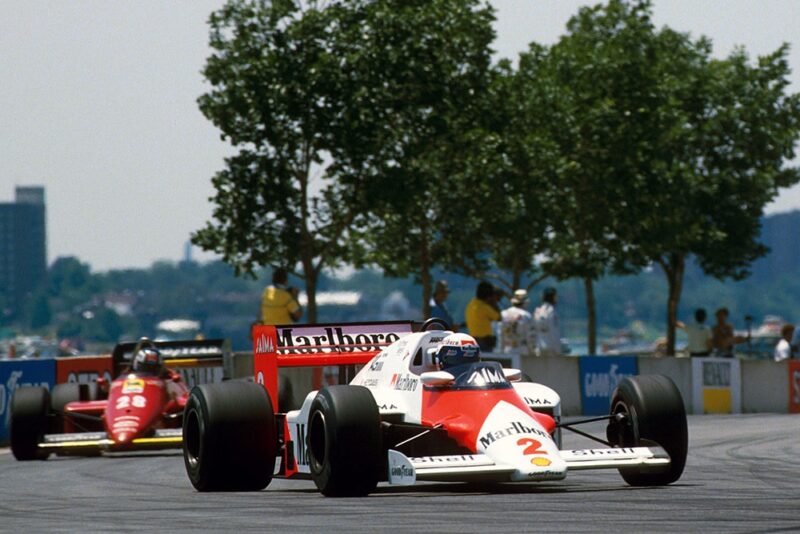
Alain Prost retired when his McLaren’s brakes failed on lap 19
Motorsport Images
Brundle was not only leading his team-mate, but actually got past AlboretoFerrari while the Italian was not ‘paying proper attention. A few laps later the red car-was ahead again, but Brundle did not give up and really “tigered” after the Ferrari .. S0 obsessed was he with his target that he got caught out when following Alboreto through a closing gap as they lapped Alliot’s RAM. The Frenchman obviously did not see the Tyrrell, and probably did not expect one to be in the slip-stream of a Ferrari, so after Alboreto had gone through the RAM moved left to place for the next corner and punted the Tyrrell sideways and up in the air, both cars ending their race there and then. It was a bit of “six of one and half a dozen of the other” but most blame must surely be put on Alliot in his slow RAM-Hart. Luckily no one was hurt.
After his first stop for tyres Senna had resumed in 12th place and had now worked his way up to seventh, in spite of being on hard tyres, so he now stopped again and this time got a set of B-Goodyears. When he rejoined the race we saw a touch of the Stirling Moss or Jim Clark, for he went like the wind, and made a row of new lap records. Out in front Rosberg was getting concerned about the rubbish collected in his radiators, so on lap 46 he steered into the pit lane to stop at his pit to have the paper cleared out. In a really fantastic effort the Williams team had a new set of tyres on the car, removed the paper and Rosberg set the . rear tyres alight down the pit lane as he rejoined the race just as the second-place Ferrari of Johansson hove into view. The Ferrari was suffering from worn out brakes, so though the Swede could see the Finn there was nothing he could do about it. Senna’s meteoric progress on decent tyres was now being hampered by worn brakes and he was having to pump up pressure before each corner, but even so was closing rapidly on Alboreto and all set to take third place. As he made a lunge to take the Ferrari going into the “marbles” corner, he forgot to pump the brakes and arrived hopelessly too fast and slid helplessly into the barrier that had already claimed Prost and Mansell. A very unusual mistake for the young Brazilian, but he made no bones about it. He admitted he had simply “goofed”.
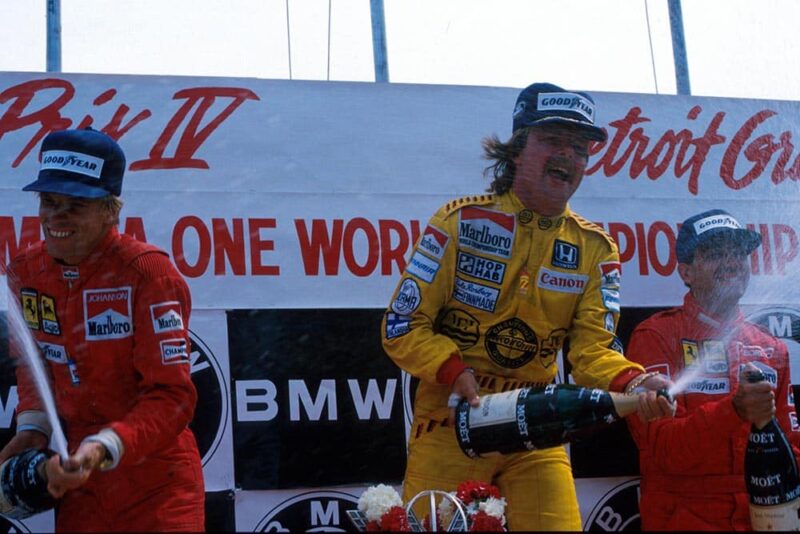
Rosberg celebrates on the podium with Johansson (left) and Alboreto
Motorsport Images
It was now all over and the worthy Rosberg won a truly resounding victory for the Williams team, followed home by the two Ferraris and Stefan Bellof in his under-powered Tyrrell 012 having run much of the race without a nose-cone. Behind him was de Angelis who had held second place for some time until Berger ran over the Lotus nose-cone while he was being lapped. A pit stop saw the damaged nose replaced by the one from the spare car, but its settings were not to the Italian’s liking and he could not really cope with the different handling and gradually lost ground.
While the Williams victory was a great morale booster for the Didcot team, the little yellow men who look after the Honda V6 engine were smiling serenely.To them winning in America’s Motor City, on the hallowed ground of the good Ford and of General Motors, was all the more sweeter.
J.H.
